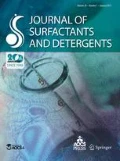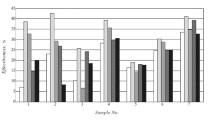Abstract
Carbonaceous deposits in automotive engines are the major problems associated with oil aging. Efficient detergents and dispersants have been used for several decades to solve this problem particularly in petroleum oils. But future lubricants and new engine hardware require development of new nontoxic detergent/dispersant additive technologies. Environmental concerns limit the formulation of the future lubricants. It requires not only the base oil to be ecofriendly but the additives also. In the present work, some of the potential ecofriendly chemical’s molecules were identified. Specific detergents applications along with effects of chemical modifications were evaluated by Blotters Spot and Panel Coker Tests. Among the studied compounds, the PIB (polyisobutylene) succinimides are showing promising results at lower temperature, while at higher temperature piperazine derivatives citrate and oleate have the best potential to be develop as ecofriendly detergent/dispersant additives.







Similar content being viewed by others
References
Willing A (2001) Lubricants based on renewable resource- an environmentally compatible alternative to mineral oil products. Chemosphere 43:89–98
Haberender T, Moore D, Lang M (2009) Eco requirements for lubricant additives. In: Rudnick LR (ed) Lubricant additives: chemistry and application, chap 26, 2nd edn. CRC Press, Taylor and Francis Group, USA
Smith GW (1986) Kinetic aspects of diesel soot coagulation. SAE, Paper 820466
Bunting BG (1991) SAE–Trans 912378, 100:1051–1057
Najman M, Kasrai M, Bancroft GM, Davidson R (2006) Combination of ashless antiwear additives with metallic detergents: interactions with neutral and overbased calcium sulfonates. Tribol Int 39:342
Pawlak Z (2003) “Role of detergent & dispersant” tribochemistry of lubricating oils. Elsevier, Amsterdam, p 25
Mortier RM, Orszulik ST (1997) “Succinimides”, chemistry and technology of lubricants, 2nd edn. Blackie Academic and Professional, London, p 75
Ahmed NS, Nassar AM, Abdel-Azim AA (2008) Synthesis and evaluation of some detergent/dispersant additives for lube oil. Int J Polym Mater 57:114–124
Seddon EJ, Friend CL, Roski JP (2010) “Detergents and Dispersants” chemistry and technology of lubricants, 3rd edn, Chapter 7. Springer Science, USA, pp 213–236
Wills JG (1980) Lubrication fundamentals. Mobil Oil Corporation, New York
Ranney MW (1978) Lubricant additives recent developments. Noyes Data Corporation, Park Ridge
Abramo GP, Hemdon Va, Blain DA, Laruel M, Cardis AB (1996) Modified succinimides as dispersants and detergents and lubricant and fuel compositions containing same. US Patent No. 5,486,301
Mekewi MA (2002) Synthesis and characterization of antioxidants and detergents dispersant based on some polyisobutylene copolymers. Mat Res Innovat 6:214–217
Wollenberg RH, Rafael S, Plavac F (1989) Modified Succinimides, US Patent Nr. 4,802,893
Guillena G, Ramon DJ, Yus M (2010) Hydrogen autotransfer in the N-alkylation of amines and related compounds using alcohols and amines as electrophiles. Chem Review 110:1611–1641
Alkylation (1978) Krik Othmer’s encyclopedia of chemical technology. Wiley, New York
Mannich C, Krosche W (1912) Über ein Kondensationsprodukt aus Formaldehyd, Ammoniak und Antipyrin. Arch Pharm 250:647–667
Padmaja KV, Rao BVSK, Bhaskar PS, Prasad RBN, Singh AK (2009) Polyol ester of medium chain fatty acid and process for preparation thereof. Wordwide patent No. WO/2009/139005
Wagner H, Luther R, Mang T (2001) Lubricant base fluids based on renewable raw materials: their catalytic manufacture and modification. Appl Catal A Gen 221:429–442
ASTM D4740–04 (2009) American standard test method: cleanliness and compatibility of residual fuels by spot test
Acknowledgments
We kindly acknowledge the Director, IIP for his kind permission to publish these results. We thank the analytical division of the Institute for providing the analyses.
Author information
Authors and Affiliations
Corresponding author
About this article
Cite this article
Singh, A.K., Singh, R.K. A Search for Ecofriendly Detergent/Dispersant Additives for Vegetable-Oil Based Lubricants. J Surfact Deterg 15, 399–409 (2012). https://doi.org/10.1007/s11743-011-1321-0
Received:
Accepted:
Published:
Issue Date:
DOI: https://doi.org/10.1007/s11743-011-1321-0




